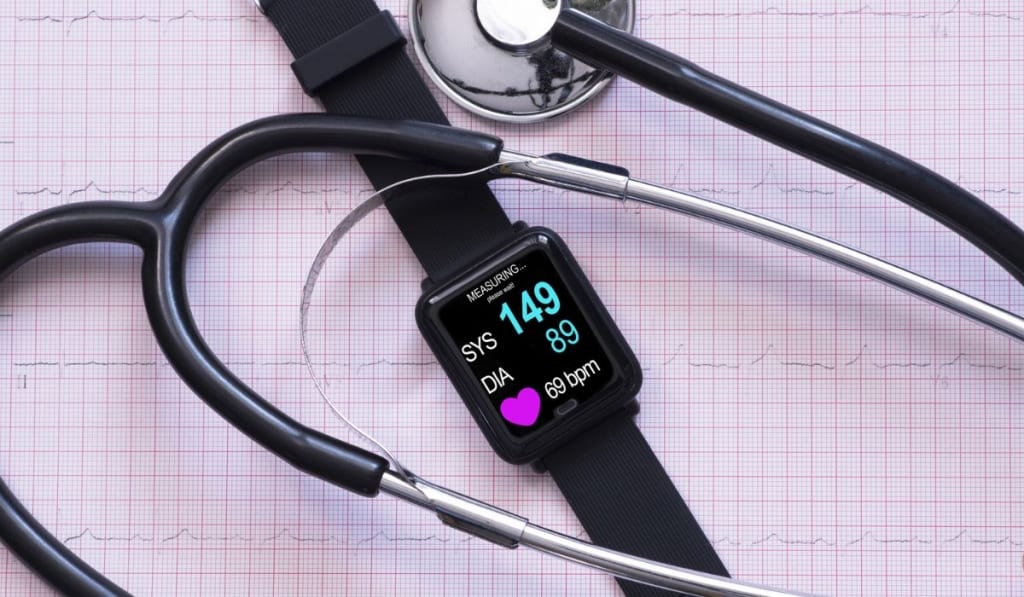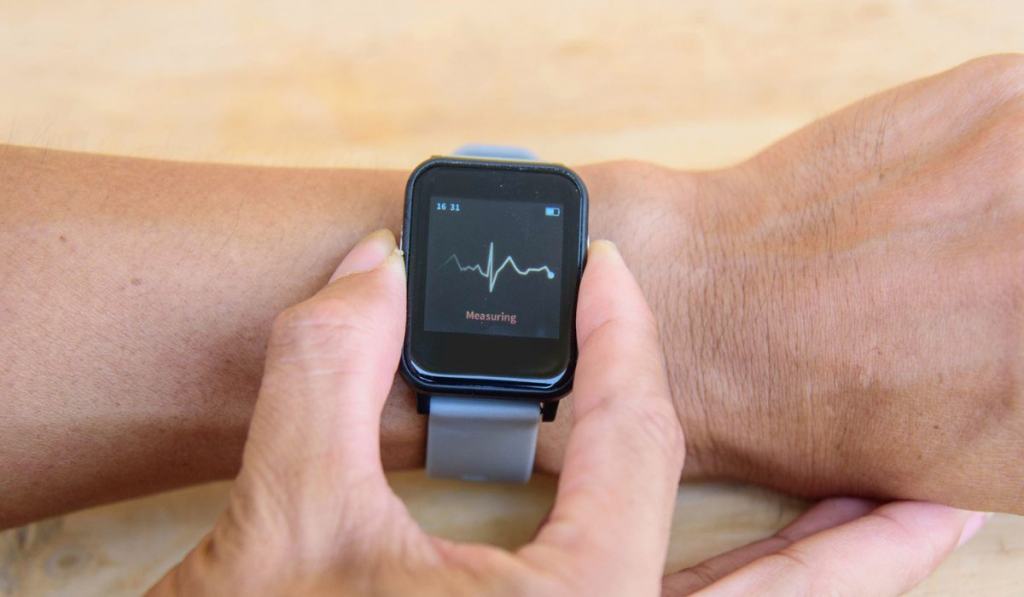Guide To The ECG Apple Watch App
The Apple Watch offers a handful of incredibly useful and versatile features. One of the most interesting tools available is the ECG software. But what exactly is the ECG mobile app, and how do you use it?
The ECG tool on the Apple Watch measures the electrical signs of your heart for any arrhythmias or irregularities. The feature is available on models with an electric heart sensor (Apple Watch Series 4 and later). Keep in mind that the ECG feature is not a replacement for a doctor’s diagnosis.
The ECG feature is a great opportunity to get insights into your heart health, rhythms, and irregularities. You’ll definitely want to experiment with this tool if you haven’t already. But there’s a lot to consider before you get started. Here’s everything you need to know about the ECG tool on your Apple Watch.
What Is an ECG?

ECG, or EKG, stands for electrocardiogram. Electrocardiograms are common and painless tests that record the electrical signals of a heart. The test is typically conducted in a health care provider’s office.
The insights and measurements from an ECG can provide you with insights into your heart’s health through heart rhythms and any irregularities.
How Do You Set Up the ECG App on the Apple Watch?
The ECG feature on the Apple Watch is only available on models with an electrical heart sensor. These models include the Apple Watch Series 4 (on Amazon) and later. You’ll need to meet the following criteria before you can set up the ECG feature:
- Ensure the ECG mobile app is available in your area. Unfortunately, the ECG software is not available in every country or region because it can be seen as a medical device. You can find a full list of compatible locations here.
- Ensure your iPhone and Apple Watch are up to date. You’ll need to update your iPhone to the latest version of iOS and Apple Watch to the newest version of watchOS.
- You must be 22 years or older. Your country or region might restrict the use of the ECG feature, depending on your age. Apple states the software is not intended for people under 22 years old, and your results might vary.
How to Install the ECG Software
- Launch the Health software from your iPhone.
- Click the ‘Browse‘ tab. Navigate towards the ‘Heart‘ tab, then ‘Electrocardiograms (ECG),’ and finally, ‘Set Up ECG App.’
- Follow the on-screen prompts to finish the installation.
The setup process is completed. You can launch the ECG software from the Apple Watch and start your first measurement. Ensure the device is fitting snugly on your wrist.
Note: If the ECG tool doesn’t appear on your Apple Watch, launch the Watch App on your iPhone and click ‘Heart.’ From the ECG tab, click ‘Install‘ to install the software.
How Do You Use the ECG Mobile App?
The Apple Watch allows you to conduct an ECG any time that you want. You can take a test when you’re feeling ill or notice odd heart symptoms. The Apple Watch can also send notifications if it detects irregular rhythms. Here’s how:
- Ensure the Apple Watch fits comfortably on your wrist or the lower section of your arm. It’s not possible to conduct an ECG measurement when the device isn’t on your arm.
- Launch the ECG software from the Apple Watch.
- Position your arms in a stable position. With the opposite hand, press your fingers on the device’s Digital Crown.
- Remain as still as possible while it’s measuring. Moving can skew the results. The ECG should only take 30 seconds to complete.
- After the measurement is finished, you will receive your results. If necessary, you can select ‘Add Symptoms.’ You can finish by clicking ‘Save‘ and then ‘Done.’
- All you have to do is launch the Health software to view your ECG measurements after saving.
The ECG results can provide you with additional context if your heart is working as usual, if you’re encountering atrial fibrillation (irregular patterns), or if your heart is beating faster or slower than usual. These measurements can be useful during your physician and primary care appointments.
Guideline for Reading ECG Results

You might come across a few different kinds of ECG results after finishing a measurement. These measurements can be hard to interpret if you aren’t sure what certain terms mean.
As always, contact your doctor or primary care physician if you aren’t feeling well or experiencing negative symptoms.
Sinus Rhythm
A sinus rhythm result is a good sign. This type of result means your heart is operating in a uniform pattern between 50 and 100 BPM. The upper and lower chambers of your heart are beating in sync.
However, a sinus rhythm is only for that particular measurement and doesn’t mean your heart beats in sync all the time. A sinus rhythm result doesn’t mean you’re healthy either, and it should not be seen as a replacement for medical attention.
Atrial Fibrillation
Your heart is operating in an irregular pattern if you come across an AFib result. Depending on the ECG software version, the software will either read AFib results between 50 and 120 BPM or 50 and 150 BPM.
AFib is a common form of irregular heart rhythms or serious arrhythmia. However, an AFib result cannot replace a diagnosis or proper medical attention. You should consult your primary care physician if you receive an AFib result.
Low or High Heart Rates
Your heart rate can affect the ECG software’s ability to search for atrial fibrillation. These ranges depend on the ECG software version. However, they’ll typically range from under 50 BPM to over 120 BPM or 150 BPM.
Certain medications, like beta-blockers, can result in a lower heart rate. If you’re an elite athlete, you might also have a lower heart rate than anticipated.
High heart rates can result from exercise, stress, heightened emotions, infection, substances, dehydration, AFib, or other complications. Neither of these measurements replaces a diagnosis or medical attention. You’ll need to contact your primary care physician for additional assistance.
Inconclusive
Inconclusive results mean that the ECG measurement can’t be classified. Inconclusive results can happen for several reasons, including:
- You’re using ECG version 1, and your heart rate is measured between 100 and 120 BPM.
- You have a pacemaker or implantable cardioverter defibrillator (ICD).
- The measurement shows signs of other irregularities or heart complications that the software doesn’t recognize.
- Select physical conditions can prevent some users from creating a strong enough signal to receive an accurate measurement.
You may also receive inconclusive results if your arms are not resting on a table during the test or the Apple Watch is too loose.
Poor Recording
The poor recording result is only available to ECG version 2. The poor recording result means your measurements can’t be classified.
Common reasons for poor recording include moving your arm too much, a loose-fitting watch, and water on your wrist or device. You can use the steps below to ensure you’re getting the most accurate results possible.
Tips for Using the ECG Mobile App on the Apple Watch
The Apple Watch ECG app is incredibly versatile, but you need to ensure you’re using it correctly to get the best results. You can use the steps below to ensure you’re receiving the most accurate ECG results possible.
- Make sure your arms are at rest on a table or in your lap while using the ECG function. Avoid moving and try to relax.
- Make sure the Apple Watch fits snuggly on your wrist. The rear side of the watch should be touching your wrist.
- Make sure the Apple Watch and your wrist are clean and free of water or debris.
- Make sure the device is on the wrist that you chose in the Apple Watch app. You can visit the ‘Watch Orientation‘ tab from the Watch app to adjust your settings.
- Stay away from any electronics that are plugged into an outlet to avoid delays and errors.
What to Do if Your ECG App Isn’t Working
Unfortunately, the ECG feature can run into issues and hiccups just like any other software. Luckily, there are steps you can take to troubleshoot and resolve any errors.
Clean Your Watch Sensors and Skin
Be sure to clean your Apple Watch’s rear sensors and your skin before taking an ECG measurement. The device and your wrist need to be clean, dry, and free of debris. Sweat, natural oils, and lotions can cause inaccurate results. You might also need to remove any cases or accessories from your device.
Stay Still While Measuring
Avoid pressing the Digital Crown when taking an ECG measurement on your Apple Watch. Instead, gently touch the crown button and ensure your finger is against the button for the entire test.
You might want to gently hold your finger against the Digital Crown before starting the ECG recording. It’s important to stay still with your arms flat during the measurement test.
You Need to Restart Your Apple Watch and iPhone
Sometimes, the most simple advice is the most appropriate. Rebooting your Apple Watch and iPhone can fix small errors and issues, including ECG test problems. Simply hold down the side buttons of your Apple Watch until the power down prompt appears.
To restart your smartphone, hold the lock button on the side of your iPhone until the power down prompt appears. These steps can vary depending on the model of your iPhone or Apple Watch and you’ll need to determine what works for you.
Delete and Reinstall the ECG Tool
You might need to delete and reinstall the ECG software to resolve minor bugs or issues. You can delete the app by swiping left on the app and moving it to the trash can.
Alternatively, you can gently press and hold the ECG icon until you see the ‘Delete‘ option. Click the ‘Delete‘ button and select ‘Delete App.’
You can easily reinstall the ECG software through the App Store on your Apple Watch. Search for either the Apple ECG app or Apple ECG app utility and select ‘Install.’ From there, you can conduct another measurement to determine if the issue was resolved.
Contact Apple Customer Support
Unfortunately, if you’re still encountering issues with your Apple Watch and ECG software, it might be time to contact Apple Customer Support. You should contact Apple Customer Support if your device is still under warranty, as you might have a hardware issue that can be replaced.
Alternatively, you might need to contact professional repair services to resolve the ECG issues.